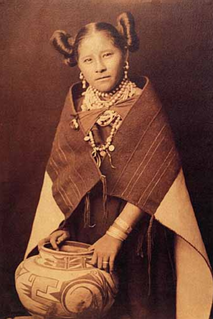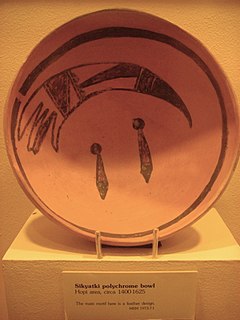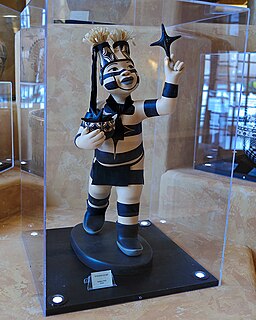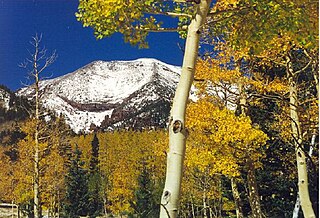Related Research Articles

The Hopi are a Native American tribe who primarily live on the Hopi Reservation in northeastern Arizona. As of the 2010 census, there are 19,338 Hopi in the United States. The Hopi Tribe is a sovereign nation within the United States and has government-to-government relations with the United States federal government. Particular villages retain autonomy under the Hopi Constitution and Bylaws. The Hopi language is one of 30 in the Uto-Aztecan language family. The majority of Hopi people are enrolled in the Hopi Tribe of Arizona but some are enrolled in the Colorado River Indian Tribes. The Hopi Reservation covers a land area of 2,531.773 sq mi (6,557.26 km2).

The Hopi maintain a complex religious and mythological tradition stretching back over centuries. However, it is difficult to definitively state what all Hopis as a group believe. Like the oral traditions of many other societies, Hopi mythology is not always told consistently and each Hopi mesa, or even each village, may have its own version of a particular story, but "in essence the variants of the Hopi myth bear marked similarity to one another." It is also not clear that the stories told to non-Hopis, such as anthropologists and ethnographers, represent genuine Hopi beliefs or are merely stories told to the curious while keeping safe the more sacred Hopi teachings. As folklorist Harold Courlander states, "there is a Hopi reticence about discussing matters that could be considered ritual secrets or religion-oriented traditions."

A kachina is a spirit being in the religious beliefs of the Pueblo peoples, Native American cultures located in the south-western part of the United States. In the Pueblo cultures, kachina rites are practiced by the Hopi, Zuni, Hopi-Tewa, and certain Keresan tribes, as well as in most Pueblo tribes in New Mexico.

In Hopi mythology, Angwusnasomtaka, also known as Tümas, is a kachina. She is a wuya, one of the chief kachinas and is considered the mother of all the hú and all the kachinas.

Chakwaina is a kachina which appears in Hopi, Zuni, and Keresan ceremonies, but does not appear in Tewa ceremonies. Although imagery of the kachina is varied, it is usually depicted as an ogre, with ferocious teeth and a black goatee and black mask with yellow eyes. Its spread throughout Pueblo culture is often associated with the Asa clan.

Jesse Walter Fewkes was an American anthropologist, archaeologist, writer and naturalist.
In Hopi mythology, Angak or Angak'china is a male Hopi kachina spirit, represented by spirit dancers and a corresponding kachina doll figure, known to non-hopis as Longhair or Long Hair. Angak is originally from the Zuni Pueblo. The goal of the Angak spirit is to bring rain and flowers to the Hopi villages. Angak sings sweet songs to bring rain. Further, he represents a healing and protective figure. There are many varieties of Angak, such as the red-bearded Hokyan Angak'china. He is present and relatively popular throughout the Hopi and Hopi-Tewa areas of Arizona and New Mexico.
Soyal is the winter solstice ceremony of the Zuni and Hopi peoples held December 21, the shortest day of the year. Participants ceremonially bring the sun back from its long slumber, mark the beginning of another cycle of the Wheel of the Year, and work on purification. Pahos prayer sticks are made prior to the Soyal ceremony, to bless all the community, including homes, animals, and plants. The sacred underground kiva chambers are ritually opened to mark the beginning of the Kachina season.

The Pueblo clowns are jesters or tricksters in the Kachina religion. It is a generic term, as there are a number of these figures in the ritual practice of the Pueblo people. Each has a unique role; belonging to separate Kivas and each has a name that differs from one mesa or pueblo to another.

Hopi katsina figures, also known as kachina dolls, are figures carved, typically from cottonwood root, by Hopi people to instruct young girls and new brides about katsinas or katsinam, the immortal beings that bring rain, control other aspects of the natural world and society, and act as messengers between humans and the spirit world.
In Hopi mythology, Ahöl Mana is a Kachina Mana, a maiden spirit, also called a kachina. She is represented as a standard Kachin Mana; it is because she arrives with Ahöla that she is called Ahöl Mana. During the Powamu ceremony, she goes with Ahöla as he visits various kivas and ceremonial houses. On these visits Ahöl Mana carries a tray with various kinds of seeds.

Kachina Peaks Wilderness is a 18,616-acre (75 km2) wilderness area about 6 miles (10 km) north of Flagstaff within the Coconino National Forest in the U.S. state of Arizona.
In Hopi mythology Nataska is the uncle of the family of "ogre Katsinas" who guard Soyok Wuhti, and who enforce good behavior among the children. Nataska is a Mongkatsina. Wiharu is a similar or identical Katsina with a white rather than black face.
In Zuni and Hopi mythology Patung is a kachina fetish that relates to healing and agriculture. The Hopi belief is that Patung showed the Puebloan peoples how to plant corn, then vanished.
In the religious beliefs of the Native American Pueblo people, Toho is a hunter kachina for the Hopi and Zuni tribes. Toho, The mountain lion kachina, often accompanies such animals as the deer or antelope kachinas when they appear in the Line Dances of spring. Armed with yucca whips, he patrols the procession in company with He-e-e, Warrior Woman, and other warrior or guard kachinas. Thought to be the most powerful hunter, the Toho is the guardian of the northern direction. He is associated with the color yellow and appears in both hunting and healing fetish sets, always facing north. Toho can be represented by a naked man wearing a mask, whiskers, and yellow feathers upon either side of his head to look like the lion's ears, or carved as a mountain lion fetish in an ancient, primitive style. Most mountain lion fetishes are represented with their tails up and over the back. Toho is there to remind individuals to persevere, clarify goals, and move forward to achieving dreams. He steadies the hunter and protects his territory.
In Hopi and Zuni dance rituals, Hú, also known as Huhuwa and Tithu, is the Kachina of the hummingbird.

Eototo is a Wuya, one of the major kachina deities of the Hopi people and the personification of nature. He is the protagonist of the Powamu ritual.
In Frank Waters's writings on Hopi mythology, the Blue Star Kachina or Saquasohuh, is a kachina or spirit, that will signify the coming of the beginning of the new world by appearing in the form of a blue star. The Blue Star Kachina is said to be the ninth and final sign before the "Day of Purification", described as an apocalypse or a "world engulfing cataclysm" that will lead to the destruction of the world. Author Jason Colavito investigated this prophecy and found no reference to it before the late twentieth century.

Neil Randall David, Sr. Is a Hopi-Tewa American Indian artist and katsina carver. He learned the basics of carving from his grandfather Victor (Kawayo) Charlie.

Tsaveyo is the Giant Ogre kachina, one of the Hopi spirit beings. There are numerous Hopi stories and legends about him. These date from the time of the Hopi migrations.